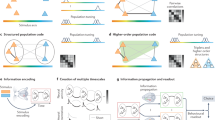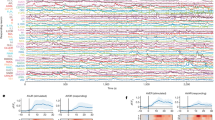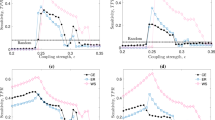Abstract
It is often assumed that cellular and synaptic properties need to be regulated to specific values to allow a neuronal network to function properly. To determine how tightly neuronal properties and synaptic strengths need to be tuned to produce a given network output, we simulated more than 20 million versions of a three-cell model of the pyloric network of the crustacean stomatogastric ganglion using different combinations of synapse strengths and neuron properties. We found that virtually indistinguishable network activity can arise from widely disparate sets of underlying mechanisms, suggesting that there could be considerable animal-to-animal variability in many of the parameters that control network activity, and that many different combinations of synaptic strengths and intrinsic membrane properties can be consistent with appropriate network performance.
This is a preview of subscription content, access via your institution
Access options
Subscribe to this journal
Receive 12 print issues and online access
$209.00 per year
only $17.42 per issue
Buy this article
- Purchase on Springer Link
- Instant access to full article PDF
Prices may be subject to local taxes which are calculated during checkout






Similar content being viewed by others
Change history
15 May 2006
Replaced figure
Notes
* NOTE: In the version of this article initially published online, the HTML version of the article did not pull up figure 5. This error has been corrected in the HTML version of the article.
References
Foster, W.R., Ungar, L.H. & Schwaber, J.S. Significance of conductances in Hodgkin-Huxley models. J. Neurophysiol. 70, 2502–2518 (1993).
Golowasch, J., Goldman, M.S., Abbott, L.F. & Marder, E. Failure of averaging in the construction of a conductance-based neuron model. J. Neurophysiol. 87, 1129–1131 (2002).
Goldman, M.S., Golowasch, J., Marder, E. & Abbott, L.F. Global structure, robustness, and modulation of neuronal models. J. Neurosci. 21, 5229–5238 (2001).
Prinz, A.A., Billimoria, C.P. & Marder, E. Alternative to hand-tuning conductance-based models: construction and analysis of databases of model neurons. J. Neurophysiol. 90, 3998–4015 (2003).
Golowasch, J., Abbott, L.F. & Marder, E. Activity-dependent regulation of potassium currents in an identified neuron of the stomatogastric ganglion of the crab Cancer borealis. J. Neurosci. 19, RC33 (1999).
Turrigiano, G.G., LeMasson, G. & Marder, E. Selective regulation of current densities underlies spontaneous changes in the activity of cultured neurons. J. Neurosci. 15, 3640–3652 (1995).
Desai, N.S., Rutherford, L.C. & Turrigiano, G.G. Plasticity in the intrinsic excitability of cortical pyramidal neurons. Nat. Neurosci. 2, 515–520 (1999).
Stemmler, M. & Koch, C. How voltage-dependent conductances can adapt to maximize the information encoded by neuronal firing rate. Nat. Neurosci. 2, 521–527 (1999).
Marder, E. & Prinz, A.A. Modeling stability in neuron and network function: the role of activity in homeostasis. Bioessays 24, 1145–1154 (2002).
MacLean, J.N., Zhang, Y., Johnson, B.R. & Harris-Warrick, R.M. Activity-independent homeostasis in rhythmically active neurons. Neuron 37, 109–120 (2003).
Harris-Warrick, R.M., Marder, E., Selverston, A.I. & Moulins, M. Dynamic Biological Networks. The Stomatogastric Nervous System (MIT Press, Cambridge, Massachusetts, USA, 1992).
Marder, E. & Thirumalai, V. Cellular, synaptic and network effects of neuromodulation. Neural Netw. 15, 479–493 (2002).
Marder, E. & Bucher, D. Central pattern generators and the control of rhythmic movements. Curr. Biol. 11, R986–R996 (2001).
Hartline, D.K. & Gassie, D.V., Jr. Pattern generation in the lobster (Panulirus) stomatogastric ganglion. I. Pyloric neuron kinetics and synaptic interactions. Biol. Cybern. 33, 209–222 (1979).
Eisen, J.S. & Marder, E. Mechanisms underlying pattern generation in lobster stomatogastric ganglion as determined by selective inactivation of identified neurons. III. Synaptic connections of electrically coupled pyloric neurons. J. Neurophysiol. 48, 1392–1415 (1982).
Marder, E. & Eisen, J.S. Transmitter identification of pyloric neurons: electrically coupled neurons use different neurotransmitters. J. Neurophysiol. 51, 1345–1361 (1984).
Maynard, D.M. Simpler networks. Ann. NY Acad. Sci. 193, 59–72 (1972).
Hartline, D.K., Gassie, D.V. & Sirchia, C.D. PY Cell Types in the Stomatogastric System of Panulirus. in The Crustacean Stomatogastric System (eds. Selverston, A.I. & Moulins, M.) 75–77 (Springer-Verlag, Berlin, 1987).
Miller, J.P. & Selverston, A.I. Mechanisms underlying pattern generation in lobster stomatogastric ganglion as determined by selective inactivation of identified neurons. IV. Network properties of pyloric system. J. Neurophysiol. 48, 1416–1432 (1982).
Hong, S.J. & Lnenicka, G.A. Characterization of a P-type calcium current in a crayfish motoneuron and its selective modulation by impulse activity. J. Neurophysiol. 77, 76–85 (1997).
Baines, R.A., Uhler, J.P., Thompson, A., Sweeney, S.T. & Bate, M. Altered electrical properties in Drosophila neurons developing without synaptic transmission. J. Neurosci. 21, 1523–1531 (2001).
Li, M., Jia, M., Fields, R.D. & Nelson, P.G. Modulation of calcium currents by electrical activity. J. Neurophysiol. 76, 2595–2607 (1996).
Leslie, K.R., Nelson, S.B. & Turrigiano, G.G. Postsynaptic depolarization scales quantal amplitude in cortical pyramidal neurons. J. Neurosci. 21, RC170 (2001).
Watt, A.J., van Rossum, M.C.W., MacLeod, K.M., Nelson, S.B. & Turrigiano, G.G. Activity coregulates quantal AMPA and NMDA currents at neocortical synapses. Neuron 26, 659–670 (2000).
Kilman, V., van Rossum, M.C.W. & Turrigiano, G.G. Activity deprivation reduces miniature IPSC amplitude by decreasing the number of postsynaptic GABAA receptors clustered at neocortical synapses. J. Neurosci. 22, 1328–1337 (2002).
LeMasson, G., Marder, E. & Abbott, L.F. Activity-dependent regulation of conductances in model neurons. Science 259, 1915–1917 (1993).
Liu, Z., Golowasch, J., Marder, E. & Abbott, L.F. A model neuron with activity-dependent conductances regulated by multiple calcium sensors. J. Neurosci. 18, 2309–2320 (1998).
Abbott, L.F. & LeMasson, G. Analysis of neuron models with dynamically regulated conductances. Neural Comput. 5, 823–842 (1993).
Bell, A.J. Self-Organization in Real Neurons: Anti-Hebb in 'Channel Space'? in Advances in Neural Information Processing Systems (eds. Moody, J., Hanson, S. & Lippmann, R.) 59–66 (Morgan Kaufmann, San Mateo, 1992).
Siegel, M., Marder, E. & Abbott, L.F. Activity-dependent current distributions in model neurons. Proc. Natl Acad. Sci. USA 91, 11308–11312 (1994).
Thoby-Brisson, M. & Simmers, J. Long-term neuromodulatory regulation of a motor pattern-generating network: maintenance of synaptic efficacy and oscillatory properties. J. Neurophysiol. 88, 2942–2953 (2002).
Turrigiano, G.G., Leslie, K.R., Desai, N.S., Rutherford, L.C. & Nelson, S.B. Activity-dependent scaling of quantal amplitude in neocortical neurons. Nature 391, 892–896 (1998).
Turrigiano, G.G. & Nelson, S.B. Hebb and homeostasis in neuronal plasticity. Curr. Opin. Neurobiol. 10, 358–364 (2000).
Turrigiano, G.G. & Nelson, S.B. Homeostatic plasticity in the developing nervous system. Nat. Rev. Neurosci. 5, 97–107 (2004).
Davis, G.W. & Bezprozvanny, I. Maintaining the stability of neural function: a homeostatic hypothesis. Annu. Rev. Physiol. 63, 847–869 (2001).
Pulver, S.R., Bucher, D., Simon, D.J. & Marder, E. Constant amplitude of postsynaptic responses for single presynaptic action potentials but not bursting input during growth of an identified neuromuscular junction in the lobster, Homarus americanus. J. Neurobiol., published online 8 September 2004 (doi:10.1002/neu.20066).
Huerta, R., Varona, P., Rabinovich, M.I. & Abarbanel, H.D.I. Topology selection by chaotic neurons of a pyloric central pattern generator. Biol. Cybern. 84, L1–L8 (2001).
Weng, G., Bhalla, U.S. & Iyengar, R. Complexity in biological signaling systems. Science 284, 92–96 (1999).
Bhalla, U.S. & Iyengar, R. Robustness of the bistable behavior of a biological signaling feedback loop. Chaos 11, 221–226 (2001).
Brezina, V., Orekhova, I.V. & Weiss, K.R. Functional uncoupling of linked neurotransmitter effects by combinatorial convergence. Science 273, 806–810 (1996).
Mutalik, V.K., Singh, A.P., Edwards, J.S. & Venkatesh, K.V. Robust global sensitivity in multiple enzyme cascade systems explains how the downstream cascade structure may remain unaffected by cross-talk. FEBS Lett. 558, 79–84 (2004).
Blüthgen, N. & Herzel, H. How robust are switches in intracellular signaling cascades? J. Theor. Biol. 225, 293–300 (2003).
Selverston, A.I. & Miller, J.P. Mechanisms underlying pattern generation in the lobster stomatogastric ganglion as determined by selective inactivation of identified neurons. I. Pyloric neurons. J. Neurophysiol. 44, 1102–1121 (1980).
Golowasch, J. & Marder, E. Ionic currents of the lateral pyloric neuron of the stomatogastric ganglion of the crab. J. Neurophysiol. 67, 318–331 (1992).
Harris-Warrick, R.M., Coniglio, L.M., Barazangi, N., Guckenheimer, J. & Gueron, S. Dopamine modulation of transient potassium current evokes phase shifts in a central pattern generator network. J. Neurosci. 15, 342–358 (1995).
Harris-Warrick, R.M., Coniglio, L.M., Levini, R.M., Gueron, S. & Guckenheimer, J. Dopamine modulation of two subthreshold currents produces phase shifts in activity of an identified motoneuron. J. Neurophysiol. 74, 1404–1420 (1995).
Abbott, L.F. & Marder, E. Modeling Small Networks. in Methods in Neuronal Modeling: From Ions to Networks (eds. Koch, C. & Segev, I.) 361–410 (MIT Press, Cambridge, 1998).
Marder, E. Cholinergic motor neurones in the stomatogastric system of the lobster. J. Physiol. (Lond.) 257, 63–86 (1976).
Selverston, A.I., Russell, D.F., Miller, J.P. & King, D.G. The stomatogastric nervous system: structure and function of a small neural network. Prog. Neurobiol. 7, 215–290 (1976).
Dayan, P. & Abbott, L.F. Theoretical Neuroscience (MIT Press, Cambridge, Massachusetts, USA, 2001).
Acknowledgements
We thank L.F. Abbott for comments on an earlier version of this manuscript. This work was supported by a grant from the National Institute of Mental Health to E.M. (MH-46742), and by the Sloan-Swartz Center for Theoretical Neurobiology at Brandeis University.
Author information
Authors and Affiliations
Corresponding author
Ethics declarations
Competing interests
The authors declare no competing financial interests.
Rights and permissions
About this article
Cite this article
Prinz, A., Bucher, D. & Marder, E. Similar network activity from disparate circuit parameters. Nat Neurosci 7, 1345–1352 (2004). https://doi.org/10.1038/nn1352
Received:
Accepted:
Published:
Issue Date:
DOI: https://doi.org/10.1038/nn1352
This article is cited by
-
Latent neural population dynamics underlying breathing, opioid-induced respiratory depression and gasping
Nature Neuroscience (2024)
-
Degeneracy in epilepsy: multiple routes to hyperexcitable brain circuits and their repair
Communications Biology (2023)
-
A biophysical perspective on the resilience of neuronal excitability across timescales
Nature Reviews Neuroscience (2023)
-
Low-dimensional models of single neurons: a review
Biological Cybernetics (2023)
-
Different parameter solutions of a conductance-based model that behave identically are not necessarily degenerate
Journal of Computational Neuroscience (2023)



